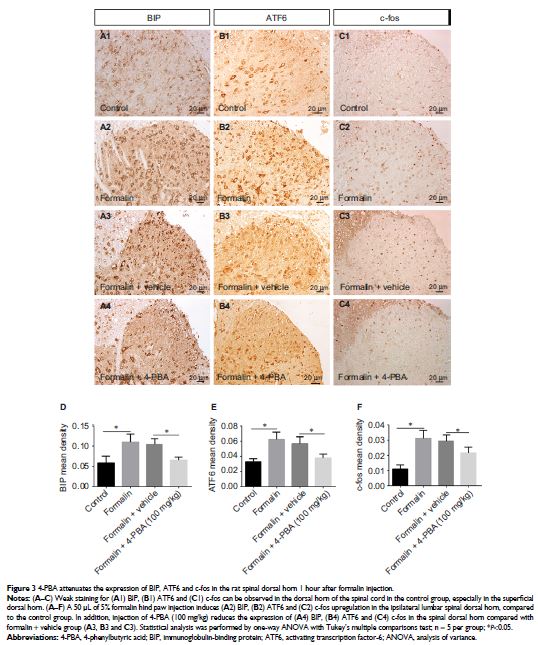100205
论文已发表
注册即可获取德孚的最新动态
IF 收录期刊
- 3.3 Breast Cancer (Dove Med Press)
- 3.4 Clin Epidemiol
- 2.5 Cancer Manag Res
- 2.9 Infect Drug Resist
- 3.5 Clin Interv Aging
- 4.7 Drug Des Dev Ther
- 2.7 Int J Chronic Obstr
- 6.6 Int J Nanomed
- 2.5 Int J Women's Health
- 2.5 Neuropsych Dis Treat
- 2.7 OncoTargets Ther
- 2.0 Patient Prefer Adher
- 2.3 Ther Clin Risk Manag
- 2.5 J Pain Res
- 2.8 Diabet Metab Synd Ob
- 2.8 Psychol Res Behav Ma
- 3.0 Nat Sci Sleep
- 1.8 Pharmgenomics Pers Med
- 2.7 Risk Manag Healthc Policy
- 4.2 J Inflamm Res
- 2.1 Int J Gen Med
- 4.2 J Hepatocell Carcinoma
- 3.7 J Asthma Allergy
- 1.9 Clin Cosmet Investig Dermatol
- 2.7 J Multidiscip Healthc

4-苯基丁酸削弱了内质网应激对福尔马林 (formalin) 诱导的疼痛影响
Authors Zhou F, Zhang W, Zhou JM, Li MR, Zhong F, Zhang Y, Liu YZ, Wang YP
Received 26 October 2016
Accepted for publication 16 February 2017
Published 20 March 2017 Volume 2017:10 Pages 653—662
DOI https://doi.org/10.2147/JPR.S125805
Checked for plagiarism Yes
Review by Single-blind
Peer reviewers approved by Dr Amy Norman
Peer reviewer comments 2
Editor who approved publication: Dr Michael Schatman
Background: Endoplasmic
reticulum (ER) stress is involved in many neurological and inflammatory
responses. Peripheral inflammatory responses can induce central sensitization
and trigger inflammatory pain. However, there is little research on the
relationship between ER stress and inflammatory pain. In this study, we
examined whether the ER stress response is involved in peripheral inflammatory
pain using a formalin-induced rat pain model.
Methods: Rats were divided into the following five groups:
control, formalin, formalin + vehicle, formalin + 4-phenylbutyric acid (4-PBA)
(40 mg/kg) and formalin + 4-PBA (100 mg/kg). Formalin-induced pain
was assessed behaviorally by recording licking activity. The expression levels
of immunoglobulin-binding protein (BIP), activating transcription factor-6
(ATF6), phosphorylated inositol-requiring enzyme-1 (p-IRE1), phosphorylated
protein kinase RNA-like ER kinase (p-PERK) and c-fos were quantitatively assessed
by Western blot, and the distribution of BIP, ATF6 and c-fos in the lumbar
enlargement of spinal cord were identified by immunohistochemistry in spinal
dorsal horn slices. In addition, the concentrations of nitric oxide (NO) and
prostaglandin E2 (PGE2) in the spinal cord were tested by biochemical
measurement and enzyme-linked immunosorbent assay (ELISA), respectively.
Results: Intraperitoneal injection of 4-PBA at the dose of
100 mg/kg before formalin injection significantly decreased nociceptive
behavior in the second phase compared with control, formalin, formalin +
vehicle and formalin + 4-PBA (40 mg/kg) (P <0.05).
Western blot showed that formalin injection significantly upregulated the
expression of BIP, ATF6, p-PERK and c-fos in the spinal cord. This upregulation
was reduced by peritoneal injection of 4-PBA (P <0.05),
while expression of p-IRE1 was not altered by formalin treatment.
Immunohistochemistry revealed markedly increased staining density for BIP, ATF6
and c-fos in the superficial spinal dorsal horn after formalin injection. This
was significantly decreased by administration of 4-PBA (P <0.05). Compared with the
formalin + vehicle group, 4-PBA inhibited the release of NO and PGE2 in the
spinal cord (P <0.05).
Conclusion: These results suggest that ER stress is involved in
formalin-induced inflammatory pain and that inhibition of ER stress may
attenuate central sensitization induced by peripheral inflammatory stimulation.
Keywords: endoplasmic reticulum stress,
formalin-induced pain, 4-phenylbutyric acid, central sensitization
